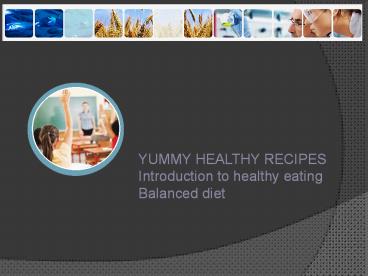yummy healthy recipes - balanced diet - PowerPoint PPT Presentation
Title:
yummy healthy recipes - balanced diet
Description:
Yummy Healthy Recipes, a blog that will help you to modernize your food into yummy options to get the best possible health for your body and soul in simple tried & tested ways, from appetizing breakfasts to healthy lunches, flavorsome dinners and finger-licking desserts. – PowerPoint PPT presentation
Number of Views:85
Title: yummy healthy recipes - balanced diet
1
YUMMY HEALTHY RECIPES Introduction to healthy
eating Balanced diet
2
Introduction
This presentation considers the many factors that
need to be taken into account when planning and
making healthy food choices. Applying your
knowledge of nutrition together with the healthy
eating guidelines will help you plan healthy and
nutritious meals.
3
Healthy eating a balanced diet
Food-based dietary guidelines (FBDG) are simple
messages on healthy eating. Most EU Member
States have food based dietary guidelines. A
balanced diet is based on these guidelines. An
unbalanced diet can lead to dietary related
diseases.
4
Food-based dietary guidelines (FBDG) give an
indication of what a person should be eating in
terms of foods rather than nutrients. They
provide a basic framework to use when planning
meals or daily menus. FBDG avoid the use of
numerical recommended intakes of nutrients but
provide a practical way of interpreting these
into dietary advice for individuals within a
population.
5
Common recommendations include eating plenty of
fruits, vegetables and complex carbohydrates, and
choosing foods which are lower in saturated fat,
salt and sugar. The use of food groups makes
sure that all the basic foods are included and
gives positive messages about what we should be
eating as well as some information to help us
avoid eating too much of certain foods.
6
Different models, consistent messages
- Although different countries use different
healthy eating models, they all have consistent
messages.
7
- Messages are
- Eat plenty of fruits and vegetables.
- Eat plenty of starchy foods, including bread,
potatoes, - rice and pasta.
- Have a moderate intake of foods of animal
origin, - including meat, fish, eggs and dairy products.
- Choose more fish.
- Choose less fatty meats and meat products.
- Choose healthy oils and fats.
- Limit intake of foods that are high in fat
and/or sugar.
8
Healthy eating models
Not every meal has to be in the recommended
proportions. However, balance should be achieved
over a day or several days.
9
Fruit and vegetables
Fruit and vegetables should make up a large
proportion of the diet. This group provides
dietary fibre, vitamin C, vitamin A, minerals and
water. Choose a wide variety of different fruit
and vegetables and aim to eat at least 5
different portions every day. Fresh, frozen,
dried, canned and juiced varieties all count.
10
Starchy foods, including bread, potatoes, rice
and pasta
Starchy foods, including bread, potatoes, rice
and pasta, should make up a good part of our
diet. Other starchy foods include breakfast
cereals, cous cous, yam, quinoa, pearl barley and
cassava.
11
Starchy foods, including bread, potatoes, rice
and pasta
This group provides starchy carbohydrate, dietary
fibre, B vitamins and minerals, e.g. iron and
calcium. Wholegrain or wholemeal varieties such
as wholegrain breakfast cereal or wholemeal bread
are high in dietary fibre. Brown rice and
potatoes also provide fibre. We should include at
least one food from this group at each meal
occasion, such as cereals at breakfast, boiled
potatoes at lunch and rice or pasta at dinner.
12
Milk and dairy foods
This is the milk and dairy foods group. A
moderate amount of these foods is needed in the
diet and they should be consumed daily. This
group includes milk, cheese, yogurt, cottage
cheese and other dairy foods. A range of
nutrients is provided, including protein, B
vitamins, vitamin A and minerals, e.g. calcium,
zinc.
13
Meat, fish, eggs and pulses
Meat, fish, eggs and pulses should be consumed in
moderate amounts. It is best to choose lean cuts
of meat and remove any visible fat. This group
provides a range of nutrients, including protein,
B vitamins, vitamins A and D and some minerals,
e.g. iron, zinc.
14
Foods and drinks high in fat and/or sugar
Foods and drinks high in fat and/or sugar should
be eaten in limited amounts. These foods should
be used sparingly if eaten every day (such as
butter, spreads and oil) or not eaten too often
(such as sweets, biscuits, cakes and some savoury
snacks).
15
Foods and drinks high in fat and/or sugar
It is important to have a small amount of fat in
the diet, but foods containing a lot of fat will
be high in energy. Foods containing high amounts
of saturated fat should only be eaten in small
amounts. Sugar adds flavour and sweetness to
foods, but frequent consumption of
sugar-containing foods and drinks is associated
with an increased tendency towards tooth decay,
especially in those with poor dental hygiene.
16
Foods and drinks high in fat and/or sugar
- Ways to enjoy this group as part of a healthy,
varied diet include - using fat in cooking sparingly
- choosing healthier fats for cooking,
- e.g. vegetable oil
- limiting products high in sugar to meal
- times only
- comparing food labels and selecting
- options that are lower in fat, saturated
- fat and sugar.
17
Composite foods
- Much of the food we eat is in the form of dishes
or meals rather than individual foods, e.g.
pizza, fish bake, spaghetti and sandwiches. - These are called composite foods.
- Composite foods are made up from more than one
food group.
18
Contact Us
- Contact person Karamjeet Kaur
- Website https//yummy-healthyrecipes.blogspot.co
m - https//www.facebook.com/RevampYourRegularFoodInto
FineDining - Twitter https//twitter.com/YHealthyrecipes
19
Yummy healthy recipes
- THANK YOU

